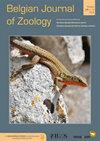人工海草群落与大洋波西多尼亚(Posidonia oceanica)的早期殖民Delile叶子
IF 1.3
4区 生物学
Q2 ZOOLOGY
引用次数: 0
摘要
许多附生植物生长在Posidonia oceanica(L.)Delile叶上,但这种定植的早期阶段尚不清楚。为了在不破坏植物的情况下研究这种早期定植,使用了人工海草单元(ASU)。研究了肉眼可见的真核生物在天然海洋P.oceanica叶片和AsUs上定植的前九天。还评估了这些AsU在长期内模仿海洋假单胞菌的能力。事实上,基质的早期殖民者可以通过“优先效应”影响后期殖民者的定居。因此,如果两种基质上的先锋群落相同,那么在更长的暴露时间后,它们更有可能是相同的。在这两种基质上,定殖开始于硬壳石灰质藻类和有孔虫的定居。AsUs上的生物数量比天然叶片上的增加更快,但海洋P.oceanica叶片的shannon-Wiener多样性指数更高。天然叶片上的低定殖率可能是由于两种基质上不同的小气候条件以及比ASU上发育较少的生物膜。在天然叶片上观察到的高度多样性主要与苔藓虫祖先的存在有关,而在AsUs上则没有。每个基质上不同的微生境(不同的藻类形态类型)可以解释这种差异。因此,在这样一个早期的殖民阶段,两种基质上的先驱群落是不同的,这表明后来的群落也会有所不同。然而,由于其高定殖率,AsUs可以代替天然叶片用于环境扰动研究。KEy WORDs:海草,人工基质,附生植物,定殖,基质偏好。本文章由计算机程序翻译,如有差异,请以英文原文为准。
Early colonization on Artificial Seagrass Units and on Posidonia oceanica (L.) Delile leaves
Many epiphytes grow on Posidonia oceanica (L.) Delile leaves but early stages of that colonization are not well known. To study this early colonization without destroying the plant, Artificial Seagrass Units (ASUs) were utilised. The first nine days of colonization by macroscopic eukaryotic organisms on natural P. oceanica leaves and on AsUs were studied. the capability of those AsUs to mimic P. oceanica in the long term was also evaluated. Indeed, early colonists of a substrate can influence the settling of later ones by “priority effects”. thus if the pioneer community is the same on both substrates, they will more likely be the same after a longer exposure time. On both substrates, colonization began by the settling of crustose-calcareous algae and foraminiferans. the number of organisms increased more quickly on AsUs than on natural leaves but shannon-Wiener diversity index was higher for P. oceanica leaves. the low colonization rate on natural leaves may have been due to different microclimatic conditions on the two substrates and to a less developed biofilm than on ASUs. The high diversity observed on natural leaves was mainly related to the presence of bryozoan ancestrulae, which were absent on AsUs. Different microhabitats on each substrate (different algae morphotypes) can explain this difference. thus, at such an early colonization stage, pioneer communities were different on the two substrates, suggesting that later communities would be different too. However, AsUs could be used in environmental perturbation studies instead of natural leaves, thanks to their high colonization rate. KEy WORDs: seagrass, artificial substrata, epiphytes, colonization, substrate preferences.
求助全文
通过发布文献求助,成功后即可免费获取论文全文。
去求助
来源期刊

Belgian Journal of Zoology
生物-动物学
CiteScore
1.90
自引率
0.00%
发文量
10
审稿时长
>12 weeks
期刊介绍:
The Belgian Journal of Zoology is an open access journal publishing high-quality research papers in English that are original, of broad interest and hypothesis-driven. Manuscripts on all aspects of zoology are considered, including anatomy, behaviour, developmental biology, ecology, evolution, genetics, genomics and physiology. Manuscripts on veterinary topics are outside of the journal’s scope. The Belgian Journal of Zoology also welcomes reviews, especially from complex or poorly understood research fields in zoology. The Belgian Journal of Zoology does no longer publish purely taxonomic papers. Surveys and reports on novel or invasive animal species for Belgium are considered only if sufficient new biological or biogeographic information is included.
 求助内容:
求助内容: 应助结果提醒方式:
应助结果提醒方式:


